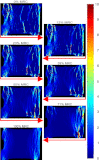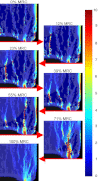Damage-based finite-element vertebroplasty simulations
- PMID: 14730441
- PMCID: PMC3476661
- DOI: 10.1007/s00586-003-0651-7
Damage-based finite-element vertebroplasty simulations
Abstract
The objectives of this study were to quantify the efficacy of vertebroplasty according to: (1) damage and (2) cement quantity (fill) and modulus. Vertebral body damage was numerically simulated using a previously validated two-dimensional finite-element model coupled with an elasto-plastic modulus reduction (EPMR) scheme. The effects of cement fill (% marrow replaced by cement, % MRC) and cement modulus on vertebral apparent modulus and trabecular bone tissue stress concentrations were parametrically assessed for four EPMR damage models (19%, 33%, 60%, and 91% modulus reduction). For this analysis, the elastic modulus of the trabecular bone tissue and marrow elements were assumed to be 10 GPa and 10 kPa, respectively. The effect of cement modulus (varied in the range 1 GPa to 9 GPa) on vertebral apparent modulus was also examined for partial fill (39% MRC) and complete fill (100% MRC) using the 33% modulus reduction damage model. In the case of polymethylmethacrylate (PMMA cement modulus = 2.16 GPa), restoration of the thoracic vertebral body (T10) apparent modulus to undamaged levels required 71% and 100% cement fill for the 19-33% and 60-91% modulus reduction damage models, respectively. Variations in cement modulus had no appreciable effect on the recovery of vertebral apparent modulus to undamaged levels for simulations of partial cement fill (39% MRC). For complete cement fill, however, a PMMA cement modulus produced approximately a 2-fold increase (82%) in vertebral apparent modulus relative to the undamaged vertebral body. Increasing the cement modulus to 9 GPa increased the vertebral apparent modulus over 2.5-fold (158%) relative to the undamaged state. The EPMR damage scheme and repair simulations performed in this study will help clinicians and cement manufacturers to improve vertebroplasty procedures.
Figures






Similar articles
-
Vertebroplasty and kyphoplasty affect vertebral motion segment stiffness and stress distributions: a microstructural finite-element study.Spine (Phila Pa 1976). 2005 Jun 1;30(11):1258-65. doi: 10.1097/01.brs.0000163882.27413.01. Spine (Phila Pa 1976). 2005. PMID: 15928549
-
Biomechanical assessment of stability in the metastatic spine following percutaneous vertebroplasty: effects of cement distribution patterns and volume.J Biomech. 2005 Aug;38(8):1582-90. doi: 10.1016/j.jbiomech.2004.07.023. J Biomech. 2005. PMID: 15958214
-
Vertebroplasty comparing injectable calcium phosphate cement compared with polymethylmethacrylate in a unique canine vertebral body large defect model.Spine J. 2008 May-Jun;8(3):482-7. doi: 10.1016/j.spinee.2006.12.007. Epub 2007 Mar 5. Spine J. 2008. PMID: 18455113
-
Biomechanical behavior of MRI-signal-inducing bone cements after vertebroplasty in osteoporotic vertebral bodies: An experimental cadaver study.Clin Biomech (Bristol). 2014 May;29(5):571-6. doi: 10.1016/j.clinbiomech.2014.03.002. Epub 2014 Mar 19. Clin Biomech (Bristol). 2014. PMID: 24703828
-
Treatment options for vertebral fractures an overview of different philosophies and techniques for vertebral augmentation.Eur J Orthop Surg Traumatol. 2014 Jul;24 Suppl 1:S131-43. doi: 10.1007/s00590-013-1257-3. Epub 2013 Jun 16. Eur J Orthop Surg Traumatol. 2014. PMID: 23771597 Review.
Cited by
-
[Vertebroplasty and kyphoplasty in patients with osteoporotic fractures: secured knowledge and open questions].Radiologe. 2006 Oct;46(10):881-92. doi: 10.1007/s00117-006-1391-6. Radiologe. 2006. PMID: 16896638 Review. German.
-
Investigating sacroplasty: technical considerations and finite element analysis of polymethylmethacrylate infusion into cadaveric sacrum.AJNR Am J Neuroradiol. 2007 Jun-Jul;28(6):1036-41. doi: 10.3174/ajnr.A0500. AJNR Am J Neuroradiol. 2007. PMID: 17569952 Free PMC article.
-
Computational modelling of bone augmentation in the spine.J Orthop Translat. 2015 Oct 1;3(4):185-196. doi: 10.1016/j.jot.2015.09.003. eCollection 2015 Oct. J Orthop Translat. 2015. PMID: 30035057 Free PMC article. Review.
-
Optimizing bone cement stiffness for vertebroplasty through biomechanical effects analysis based on patient-specific three-dimensional finite element modeling.Med Biol Eng Comput. 2018 Nov;56(11):2137-2150. doi: 10.1007/s11517-018-1844-x. Epub 2018 May 28. Med Biol Eng Comput. 2018. PMID: 29806053
-
Early stage disc degeneration does not have an appreciable affect on stiffness and load transfer following vertebroplasty and kyphoplasty.Eur Spine J. 2009 Jan;18(1):59-68. doi: 10.1007/s00586-008-0828-1. Epub 2008 Nov 26. Eur Spine J. 2009. PMID: 19034533 Free PMC article.
References
Publication types
MeSH terms
Substances
LinkOut - more resources
Full Text Sources
Medical
Research Materials

